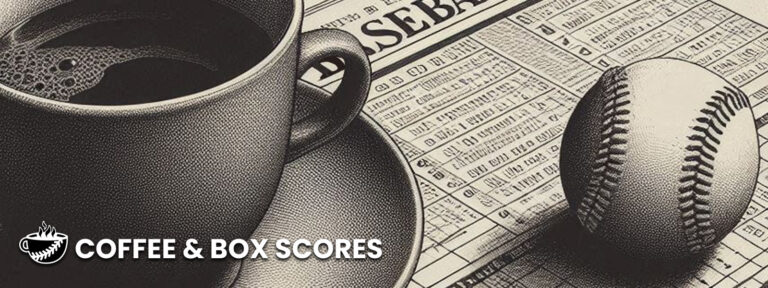This past season, Royals All-Star Bobby Witt, Jr. – AL batting champ, runner-up in league MVP voting, Silver Slugger, Gold Glover, producer of the second highest extra-base hit tally ever for a shortstop – also enjoyed a flirtation with hitting .400 … at home. The dalliance fell short, leaving the 24-year-old with a .382 mark at Kauffman Stadium (based on his at-bats, if he had collected six more knocks, he would’ve finished at .401). That .382 tied for the 147th highest home average (minimum 250 plate appearance) since 1901, matched with Jimmy Sheckard in 1901, Benny Kauff in 1915, Baby Doll Jacobson in 1921, Stan Musial in 1953, Wally Moon in 1961, Tony Gwynn in 1993 and fellow Royal Hal McRae in 1976. The pair of Kansas City batters also share the second highest home mark in franchise history, looking up at George Brett and his .392 in 1980.
George Brett and 1980: a name and a year that are securely and everlastingly twined together, addends that instantly equal, in baseball’s math, .400. Brett’s chase of the magical number and its implied bond with the equally magical name of Ted Williams is part of the game’s lore, effervescent even after that pursuit sits untouched for more than four decades.
Therein lies the power of .400, that numerical incantation that conjures not only Brett and Williams, but Ty Cobb and Tony Gwynn, Rod Carew and Rogers Hornsby, Shoeless Joe and Wee Willie. Witt’s overall league-leading mark landed at .332, but his chances of even touching .400 while batting at home injected some additional zip into his remarkable campaign. Hitting .400 – at home or on the road for a full season, before or after an All-Star break: even these compartmentalizations stir the imagination.
In the American and National Leagues since 1901, 63 batters have finished a season with at least 250 plate appearances and a .400 average at home. Unsurprisingly, the past few decades have witnessed Colorado Rockies players dominate this split, submitting six of the last seven campaigns that meet the criteria. Andrés Galarraga (1993), Eric Young (1996) and Jeff Cirillo (2000) show up, as does Larry Walker three times, cresting with a gasp-worthy .461 in 1999. The other representative also comes out of the NL West, in the form of Barry Bonds in 2004. But back to Walker’s wacky ’99 effort. Well, that was the highest for a player at home since Chuck Klein hit .467 for the Phillies in 1933. Only four averages exceed Klein’s apex, with Joe Jackson’s .480 for Cleveland in 1912 representing the top mark.
In contrast to the relative frequency of hitting .400 at home, the road maestros are a more limited collection, totaling just 24. It’s happened just three times since Jackie Robinson debuted for the Brooklyn Dodgers: Stan Musial and Lou Boudreau in 1948 and then – long after – Ichiro Suzuki in 2004. Only one player in the modern era reached .450 on the road: not Cobb, Hornsby, Jackson, Williams nor any of the other usual go-tos when .400 hitters are passed around the conversation. Instead of any of the easy answers, we alight upon a figure who made just missing .400 for an entire season an art form: Hall of Fame outfielder Harry Heilmann.
In 1925, the Tigers star had 134 hits in 295 at-bats on the road to clock an astounding .454 mark. The righty’s incomparable traveling show lifted a rather pedestrian (for him) effort at Navin Field – a .326 average – to place the right fielder in a familiar spot at year’s end: a .393 to pace the AL in batting for the third time in his career.
Rather famously, Heilmann’s pattern of leadership and high averages was spaced out at even intervals: his first crown arrived in 1921, when he batted .394, a second title came in 1923 when he joined the .400 club with a .403 mark. And then the title in ‘25, spurred by those showoff-y manners when visiting others’ homes. The pattern offered one more detail in 1927, when Heilmann led with a .398 average; this time, the home and road efforts were flipped, with the 33-year-old ending with a .434 mark in Detroit versus a .363 when wearing the road grays.
Let’s take some stock in a summary fashion at this stage, for the pinpointed celebrations around Heilmann’s relationship with a .400 average are quite a sight.
Altogether, Heilmann produced five seasons of at least 250 plate appearances and a road or home average of at least .400. That tally ties for the third most since 1901, putting him just under Hornsby (who had eight such campaigns) and his outfield mate for a dozen seasons, Cobb (8), and matching him with Joe Jackson.
In a quirkier view, Heilmann’s three oh-so-close-brushes with hitting .400 puts him in a room for one, the only player in history to have so many campaigns that saw him qualify for the batting title and finish the year with an average between .390 and .399. Imagine the what-if of those three years – with just a little more fortune, Heilmann could’ve produced a quartet of .400 campaigns, a pinnacle that has no claimants in NL/AL history (Cobb, Hornsby and Ed Delahanty each have three).
For such an oft-experienced affair with the magical number, Heilmann has less of a presence in the game’s legend, more afterthought in comparison with some of the other magicians who’ve put on shows in the batter’s box. Despite the four batting titles (tied for ninth most in AL/NL history), despite being one of 20 players in history with at least 5,000 plate appearances and a .300/.400/.500 career line, despite owning the 10th highest average (min. 5,000 PA) ever, despite his connection to the instantly recognizable .400 benchmark, he lives in a dimmer corner of Olympus.
The 1920s were a great decade to flirt with .400 – of the 25 times in the modern era an AL or NL qualified batter has hit at least .390, 14 of them show up between 1920 and 1929. Heilmann gets lost in the shuffle of that decade, to an extent: a high average savant who paired that brilliance with pedestrian home run numbers; someone known more for just missing the mark than toppling it; someone with an intriguing pattern of odd-year specialness as opposed to the more demonstrative chunk of an uninterrupted string. Nevertheless, he’s an essential name when it comes to one of the game’s essential numbers.
Maybe there will be another sustained run at .400 – it’d capture imaginations and add electricity to honing in on a very specific element to each morning’s box scores. Maybe an All-Star break will arrive and there will be, like Carew in 1983, a league-leader sitting above the mark (he was at .402 that season). If the storyline comes to life, it’s certain that names like Brett and Gwynn and Carew and Williams will collide in the everyday conversations, and perhaps even the glorious run of Harry Heilmann will emerge from the deep past to color the present.
Thanks to Baseball Reference and its extraordinary research database, Stathead, for help in assembling this piece.

Roger Schlueter
As Sr. Editorial Director for Major League Baseball Productions from 2004-2015, Roger served as a hub for hundreds of hours of films, series, documentaries and features: as researcher, fact-checker, script doctor, and developer of ideas. The years at MLB Production gave him the ideal platform to pursue what galvanized him the most – the idea that so much of what takes place on the field during the MLB regular and postseason (and is forever beautifully condensed into a box score) has connections to what has come before. Unearthing and celebrating these webs allows baseball to thrive, for the present can come alive and also reignite the past.


